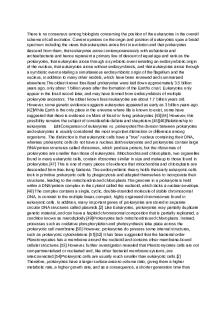Lecture 5 PDF

| Title | Lecture 5 |
|---|---|
| Course | Human Bonding |
| Institution | Cornell University |
| Pages | 2 |
| File Size | 38.8 KB |
| File Type | |
| Total Downloads | 73 |
| Total Views | 148 |
Summary
Lecture 5 Notes for Cindy Hazan's Human Bonding course....
Description
Lecture 5:
Strange situation paradigm o Introduced baby in situation with mother and stranger, cycled through baby pairings between mother and stranger o Baby-mother reunions were investigated after separation Major discovery o Secure pattern (B): the majority of babies, but not all, seek contact and is fully soothed when caregiver returns (67%) In all normative samples, 2/3 of babies show this predictable pattern o Ambivalent pattern (C): hen caregiver returns baby seeks contact but is not fully soothed, actively resists comfort (12%) o Avoidant pattern (A): hen caregiver returns baby actively avoids contact (21%) o In regions where parents place high importance on independence, avoidant pattern is a little higher. Secure pattern is nearly constant across cultures Ainsworth’s Baltimore Study o Method: every other week for the first three months, researchers observed and noted mother-infant interactions o Finding: one reliable predictor of infant’s strange situation attachment style Caregiver responsiveness o Caregiver responsiveness is characterized by three traits Notice Interpret Crying is a graded symbol Baby’s cry differently for different inputs Respond (promptly) Attachment styles and caregiving antecedents o Pattern B babies: caregivers were consistently responsive o Pattern C babies: caregivers were inconsistently responsive o Pattern A babies: caregivers were consistently unresponsive Overview of attachment patterns o Organized patterns break down into secure and insecure, insecure breaks down into ambivalent and avoidant o Disorganized (D) pattern: start to approach, and then pull back. Not sure if they want contact or want to avoid contact Caregiver responsiveness or child temperament o Neonatal differences is stress reactivity o Different styles (reactive patterns) with different caregivers This suggests that this variation isn’t due to inborn temperament, rather how they have been treated by different people
o Responsiveness training changes styles o Neonatal temperament does not predict styles o Ainsworth: there is no good reason not to be responsive to your baby Lasting effects of early bonding experiences o Experiences confer expectations confer behaviors confer experiences etc… o Result: you have the same experiences again and again o The ANS & HPA (brain body systems which regulate anxiety and arousal) is affected by the above loop...
Similar Free PDFs

5 - Lecture notes 5
- 4 Pages

Lecture 5
- 26 Pages

Lecture 5
- 2 Pages

Lecture 5
- 3 Pages

Lecture 5
- 2 Pages

Lecture 5
- 8 Pages

Lecture 5
- 3 Pages

Lesson 5 - Lecture notes 5
- 22 Pages

5 Statehood - Lecture notes 5
- 4 Pages

Prokaryotes 5 - Lecture notes 5
- 2 Pages

5. Conduct - Lecture notes 5
- 4 Pages

Chapter 5 - Lecture notes 5
- 15 Pages

Chapter-5 - Lecture notes 5
- 6 Pages

Chapter 5 - Lecture notes 5
- 83 Pages

Tutorial 5 - Lecture notes 5
- 3 Pages

Chapter 5 - Lecture notes 5
- 4 Pages
Popular Institutions
- Tinajero National High School - Annex
- Politeknik Caltex Riau
- Yokohama City University
- SGT University
- University of Al-Qadisiyah
- Divine Word College of Vigan
- Techniek College Rotterdam
- Universidade de Santiago
- Universiti Teknologi MARA Cawangan Johor Kampus Pasir Gudang
- Poltekkes Kemenkes Yogyakarta
- Baguio City National High School
- Colegio san marcos
- preparatoria uno
- Centro de Bachillerato Tecnológico Industrial y de Servicios No. 107
- Dalian Maritime University
- Quang Trung Secondary School
- Colegio Tecnológico en Informática
- Corporación Regional de Educación Superior
- Grupo CEDVA
- Dar Al Uloom University
- Centro de Estudios Preuniversitarios de la Universidad Nacional de Ingeniería
- 上智大学
- Aakash International School, Nuna Majara
- San Felipe Neri Catholic School
- Kang Chiao International School - New Taipei City
- Misamis Occidental National High School
- Institución Educativa Escuela Normal Juan Ladrilleros
- Kolehiyo ng Pantukan
- Batanes State College
- Instituto Continental
- Sekolah Menengah Kejuruan Kesehatan Kaltara (Tarakan)
- Colegio de La Inmaculada Concepcion - Cebu